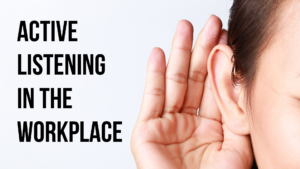Reflective Listening in the Workplace

What’s the next way to innovate the workplace? How can we reach the next generation of workers? How can we maximize time and money? These are some of the questions that business leaders are constantly asking. But in an age where information is instantly at our fingertips, there’s no need to reinvent the workplace wheel.
I was in a meeting with a sales educator recently, and she shared that the feedback she’s been giving so many clients right now is to ask more questions. Asking helpful open-ended questions helps frame the situation from a prospect’s perspective rather than what the salesperson assumes it to be.
This prompted my thoughts about a workshop I recently facilitated about intergenerational mentoring. While the workshop as a whole was about mentoring, a major focus was on having meaningful conversations using reflective listening. Reflective listening is an important part of fostering positive relationships (and asking good questions) in the workplace, so I want to dive into this topic today.
Why Listen Well?
We’ve all been in an interaction where someone interrupted us or was clearly disengaged from the conversation. How did that make you feel? It doesn’t make me feel good. In fact, it makes me feel like the other person doesn’t care about me, my experience, or my opinions.
Now some may think, “that sounds like mushy-gushy, fluffy, fruity stuff.” And there are contexts where you could make that argument, but being listened to, seen, and heard is incredibly valuable in all sorts of situations. Having a supervisor genuinely listen to you makes all the difference in the workplace!
Listening well communicates that the listener values the speaker and allows for true comprehension of what the speaker is saying. When we listen well, we build trust and create a space for an open and honest conversation with genuine feedback: a healthier workplace and higher work quality results.
Are People Good Listeners?
Unfortunately, most people aren’t very good listeners, but they think they are. In fact, an Accenture report states that 96% of global professionals think they’re good listeners, but 80% of the study participants tend to multi-task on conference calls. Another study notes that people only retain about 50% of what others say.
We can consolidate these sentiments in the common phrase “people listen to respond, not to understand.” On average, people spend about 45% of their conversational time listening and 30% talking. We spend much of that listening time thinking about what we’re going to say next or not thinking about what the other person is saying at all.
Think about your own conversations, whether in the workplace, at home, or elsewhere. When you’re listening, are you actually thinking about and empathizing with what the other person is sharing, or are you thinking about what you will say next? Contemplate that and be honest with yourself… I find myself listening to respond quite often.
If listening isn’t your best strength, have no fear! As we dive into the theory of reflective listening, you’ll gain some practical techniques to improve your listening.
How to Listen Well
The theory of reflective listening comes from theories in psychotherapy and counseling*, particularly Carl Roger’s “client-centered” therapy. This conversational technique focuses on helping the speaker to deal with or process something.
In the workplace, whether you’re a manager receiving feedback from an employee to improve the work environment or an employee helping someone in upper management address a problem, reflective listening can open channels for genuine connection and real problem-solving.
Listening Orientation
Before we can understand reflective listening technique, the listener must first understand how to orient themselves to listen well. Rogers and others in his field delineate the four qualities of listening orientation:
- Empathy – This is the listener’s desire to understand the speaker from the speaker’s perspective, emotions, and thoughts rather than their own point of view.
- Acceptance – This means that the listener respects the speaker for simply being a person; this is as unconditional as possible. It also means that the listener, at least initially, limits their expression of agreement, disagreement, or other qualifying expressions. This supports an environment where the speaker doesn’t feel a need to be defensive. It doesn’t mean the listener never expresses their opinion, but keeping an objective mindset at the beginning creates a safer space for open discussion.
- Congruence – The listener must be aware of their own biases and emotional state when entering an interaction. A genuine expression of these feelings and perspectives helps the speaker understand where the listener is at. Plus, honesty from one party will often lead to honesty from the other. It’s worth noting that listeners will sometimes restrict an honest expression of emotions in an attempt to be friendly and accepting, but that can get in the way of fostering genuine trust.
- Concreteness – In any conversation, it’s easy to rush to vague generalities to avoid painful emotions. In the workplace, this might look like “Managers act like they care about you, but they’ll throw you under the bus if it makes them look good.” As the listener, it’s helpful to ask for specific examples to clearly understand the situation you’re dealing with.
*Note that we’re talking about a conversational technique created for therapeutic contexts which is also helpful in the workplace. That’s not to say that interactions in the workplace need to become therapeutic, just that this technique helps foster productive conversations no matter the setting.
What is Reflective Listening?
Simply put, reflective listening is saying back to someone what they’ve said to you. The reflection is the listener’s restatement and clarification of the speaker’s words. This has three goals:
- To increase the listener’s understanding of the speaker’s view,
- To help the speaker clarify their thoughts; and
- To reassure the speaker that the listener genuinely cares and wants to support them.
There are two main steps to make this work in a conversation:
- Restate back the person’s statement/experience,
- Clarify that your reflection of their statement is accurate.
The attitudes of proper listener orientation mentioned previously work in tandem with reflective listening. Whereas empathy, acceptance, congruence, and concreteness help you make effective reflective responses, reflection helps to grow the principles of listener orientation.
According to Dalmar Fisher’s Communication in Organizations, other principles of reflective listening include:
- More listening than talking.
- Responding to what is personal rather than to what is impersonal, distant, or abstract.
- Restating and clarifying what the other has said, not asking questions or telling what the listener feels, believes, or wants.
- Trying to understand the feelings contained in what the other is saying, not just the facts or ideas.
- Working to develop the best possible sense of the other’s frame of reference while avoiding the temptation to respond from the listener’s frame of reference.
- Responding with acceptance and empathy, not with indifference, cold objectivity, or fake concern.
The ultimate goal of the reflective listening process is to help the speaker better understand their own situation and, if applicable, take appropriate action. The listener should focus on responding to the speaker rather than leading the conversation. In reflecting and clarifying the speaker’s statement, the listener provides space for the speaker to build on their thoughts.
In addition to responding to the content, the listener must also understand and respond to the emotion that the speaker projects, whether explicit or implicit. The listener should respond to both positive and negative emotions to communicate acceptance and understanding of the situation.
You can read more about these listening techniques here.
Reflective listening promotes trust, effective problem-solving, and a healthier work environment. So whether you’re talking with a decision-maker, employee, or industry peer, always remember that people are people are people. They want to be seen and understood. Listening well makes sure that they both feel seen and understood and are seen and understood.
Check out more workplace best practices on our blog, or podcast found on YouTube, downloadable audio, or wherever you get your podcasts.
